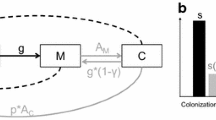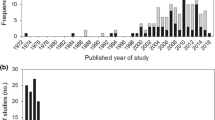Abstract
Accidental introductions of nonindigenous invasive species impair ecosystems, increase the risk of native species extinctions, and cause substantial economic damages on a worldwide basis. Despite the magnitude of the problem, very little economic analysis has been focused on this topic to date. This manuscript develops an optimal control model of the management of a nonindigenous species stock following its introduction and establishment. We find that the influence of changes in ecological and human factors (such as the invader's intrinsic growth rate, carrying capacity, and the effectiveness of invasive species management technologies) on the optimal level of management are analytically (mathematically) ambiguous in sign and depend on the values of other parameters and variables. To estimate actual numerical solutions to the model and conduct sensitivity analyses, we construct a case study illustration based on invasive plant species on arid lands. The illustration shows that the optimal level of management effort is sensitive to biological and ecological factors (the stock's intrinsic rate of growth, the carrying capacity afforded the invasive species, and the form of the invader's growth function) that are species- and site-specific as well as uncertain given currently available scientific information. This highlights the need for better collaboration and information transfer between economists and scientists interested in this topic. Given that resources for addressing nonindigenous species threats typically are quite constrained, and complete eradication in a particular area is often technically infeasible, the model provides useful insight on optimal levels of ongoing management and how they may vary according to bioeconomic factors.
Similar content being viewed by others
References
Bell, C. E. (1996), Saltcedar: A Non-native Invasive Plant in the Western U.S. University of California, Berkeley: University of California Cooperative Extension Service.
Callihan, R. and J. Evans (1991) 'Weed Dynamics on Rangeland', in James, Evans, Ralphs and Child, eds., Noxious Range Weeds (pp. 55–61). Boulder, CO: Westview Press.
Carlton, J. T. and J. B. Geller (1993), 'Ecological Roulette: The Global Transport of Nonindigenous Marine Organisms', Science 261, 78–82.
Clark, C. W. (1990), Mathematical Bioeconomics. 2nd ed. New York: John Wiley and Sons, Inc.
Crocker, T. D. and J. Tschirhart (1992), 'Ecosystems, Externalities, and Economies', Environmental and Resource Economics 2, 551–567.
Dalmazzone, S. (2000), 'Economic Factors Affecting Vulnerability to Biological Invasions', in C. Perrings, M. Williamson and S. Dalmazzone, eds., The Economics of Biological Invasions. Cheltenham: Elgar Press.
D'Antonio, C. M. and P.M. Vitousek (1992), 'Biological Invasions by Exotic Grasses, the Grass/Fire Cycle, and Global Change', Annual Review of Ecology and Systematics 23, 63–87.
DiCastri, F., A. H. Hansen and M. Debussche (eds.) (1990), Biological Invasions in Europe and the Mediterranean Basin. Monographiae Biologicae 65. Leiden, Netherlands: Kluwer Academic.
Eiswerth, M. E. (1993), 'Using Dynamic Optimization for Integrated Environmental Management: An Application to Solvent Waste Disposal', Land Economics 69(2), 168–180.
FICMNEW (Federal Interagency Committee for Management of Noxious and ExoticWeeds) (1997), Pulling Together: National Strategy for Invasive Plant Management, unpub. Data.
Forster, B. A. (1977), 'On a One State Variable Optimal Control Problem: Consumption-Pollution Tradeoffs', in J. D. Pitchford and S. J. Turnovsky, eds., Applications of Control Theory to Economic Analysis. Amsterdam: North Holland.
Gordon, H. S. (1954), 'The Economic Theory of a Common Property Resource: The Fishery', Journal of Political Economy 62, 124–142.
Griffith, D. and J. R. Lacey (1991), 'Economic Evaluation of Spotted Knapweed [Centaurea maculosa] Control Using Picloram', Journal of Range Management 44(1), 43–47.
Hale, J. and H. Kocak (1991), Dynamics and Bifurcations. New York: Springer-Verlag.
Hengeveld, R. (1989), Dynamics of Biological Invasions. London: Chapman and Hall.
Higgins, S. I., E. J. Azorin, R. M. Cowling and M. J. Morris (1997), 'A Dynamic Ecologicaleconomic Model as a Tool for Conflict Resolution in an Invasive-Alien-Plant, Biological Control and Native-Plant Scenario', Ecological Economics 22, 141–154.
Hill, G. and D. Greathead (2000), 'Economic Evaluation in Classical Biological Control', in C. Perrings, M. Williamson and S. Dalmazzone, eds., The Economics of Biological Invasion. Cheltenham: Elgar Press.
Huffaker, R. and K. Cooper (1995), 'Plant Succession as a Natural Range Restoration Factor in Private Livestock Enterprises', American Journal of Agricultural Economics 77, 901–913.
International Union for the Conservation of Nature and Natural Resources (IUCN) (1991), Caring for the Earth: A Strategy for Sustainable Living. Gland, Switzerland: IUCN.
Keeler, E., M. Spence and R. Zeckhauser (1971), 'The Optimal Control of Pollution', Journal of Economic Theory 4, 19–34.
Knowler, D. and E. B. Barbier (2000), 'The Economics of an Invading Species: A Theoretical Model and Case Study Application', in C. Perrings, M. Williamson and S. Dalmazzone, eds., The Economics of Biological Invasions. Cheltenham: Elgar Press.
Leistritz, F. L., F. Thompson and J. A. Leitch (1992), 'Economic Impact of Leafy Spurge in North Dakota', Weed Science 40, 275–280.
Luken, J. O. and J. W. Thieret (eds.) (1997), Assessment and Management of Plant Invasions. New York: Springer-Verlag.
Madsen, J. D. (1997), 'Methods for Management of Nonindigenous Aquatic Plants', in J. O. Luken and J. W. Thieret, eds., Assessment and Management of Plant Invasions (pp. 145–171). New York: Springer-Verlag.
Olson, B. E. (1999), 'Impacts of Noxious Weeds on Ecologic and Economic Systems', in R. L. Sheley and J. K. Petroff, eds., Biology and Management of Noxious Rangeland Weeds (pp. 4–18). Corvallis, OR: Oregon State University Press.
Perrings, C. (2000), 'The Economics of Biological Invasions', Paper prepared for the workshop on Best Management Practices for Preventing and Controlling Invasive Alien Species. South Africa/United States of America Bi-National Commission, 22-24 February. http://www.york/ac.uk/depts/eeem/gisp/Perrings_Capetown.htm.
Perrings, C., M. Williamson and S. Dalmazzone (eds.), The Economics of Biological Invasions. Cheltenham: Elgar Press.
Pindyck, R. (1980), 'Uncertainty and Exhaustible Resource Markets', Journal of Political Economy 88, 1203–1225.
Plourde, C. G. (1972), 'A Model of Waste Accumulation and Disposal', Canadian Journal of Economics 5, 119–125.
Reid, W. V. and K. R. Miller (1989), Keeping Options Alive: The Scientific Basis for Conserving Biodiversity. Washington, D.C.: World Resources Institute.
Roche, B., J. Lacey, T. Bedell and K Sanders (1994), Knapweed. Washington Interagency Knapweed Committee Newsletter, Washington State Cooperative Extension Service, Vol. 8, No.1, May.
Sala, A., S. D. Smith and D. A. Devitt (1996), 'Water Use by Tamarix Ramosissima and Associated Phreatophtyes in a Mojave Desert Floodplain', Ecological Applications 6(3), 888–898.
Schaefer, M. B. (1957), 'Some Considerations of Population Dynamics and Economics in Relation to the Management of Marine Fisheries', Journal of the Fisheries Research Board of Canada 14, 669–681.
Sharov, A. A. and A. M. Liebhold (1998), 'Bioeconomics of Managing the Spread of Exotic Pest Species with Barrier Zones', Ecological Applications 8(3), 833–845.
Sharov, A. A., A. M. Liebhold and E. Anderson Roberts (1998), 'Optimizing the Use of Barrier Zones to Slow the Spread of Gypsy Moth (Lepidoptera: Lymantriidae) in North America', Journal of Economic Entomology 91(1), 165–174.
Sheley, R. L. and J. K. Petroff (eds.) (1999), Biology and Management of Noxious Rangeland Weeds. Corvallis, OR: Oregon State University Press.
Sheley, R., M. Manoukian and G. Marks (1996), 'Preventing Noxious Weed Invasion', Rangelands 18(3), 100–101.
Shigesada, N. and K. Kawasaki (1997), Biological Invasions: Theory and Practice. Oxford: Oxford University Press.
Shogren, J. (2000), 'Risk Reduction Strategies Against the “Explosive Invader”', in C. Perrings, M. Williamson and S. Dalmazzone eds., The Economics of Biological Invasions. Cheltenham: Elgar press.
Smith, H. A., W. S. Johnson, J. S. Shonkwiler and S. R. Swanson (1999), 'The Implications of Variable or Constant Expansion Rates in Invasive Weed Infestations', Weed Science 47, 62–66.
Universita degli Studi di Sassari, Italy (1999), Proceedings of the 5th International Conference on the Ecology of Invasive Alien Plants. Italy: La Maddalena, Sardinia, 13-16 October.
U.S. OTA (1993), Harmful Nonindigenous Species in the United States. Washington, DC: U.S. Congress, Office of Technology Assessment.
van Kooten, G. C. and E. H. Bulte (2000), The Economics of Nature: Managing Biological Assets. Malden, MA: Blackwell Publishers Inc.
White, J. (1999), 'Can Integrated Methods Stop Starthistle?', California Agriculture 53(2), 7.
Williamson, M. (1996), Biological Invasions. London: Chapman & Hall.
Wilson, R. E. and J. A. Young (1997), Managing Invasive Noxious Range Weeds in the Great Basin. University of Nevada, Reno: University of Nevada Cooperative Extension Publication SB-97-03.
Young, J. A. and W. S. Longland (1996), 'Impact of Alien Plants on Great Basin Rangelands', Weed Technology 10(2), 384–391.
Author information
Authors and Affiliations
Rights and permissions
About this article
Cite this article
Eiswerth, M.E., Johnson, W.S. Managing Nonindigenous Invasive Species: Insights from Dynamic Analysis. Environmental and Resource Economics 23, 319–342 (2002). https://doi.org/10.1023/A:1021275607224
Issue Date:
DOI: https://doi.org/10.1023/A:1021275607224




